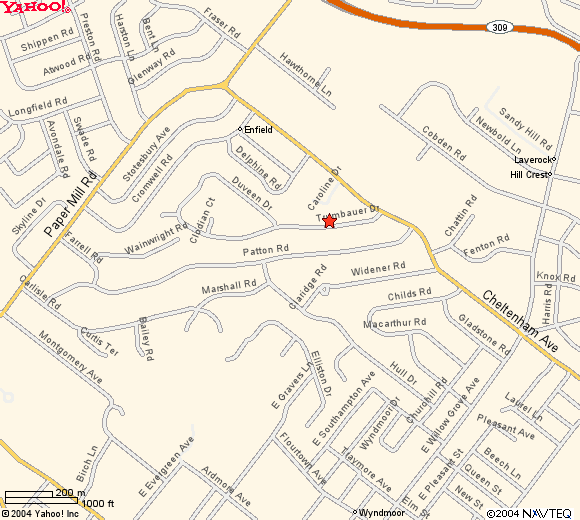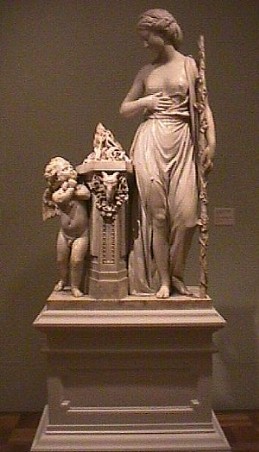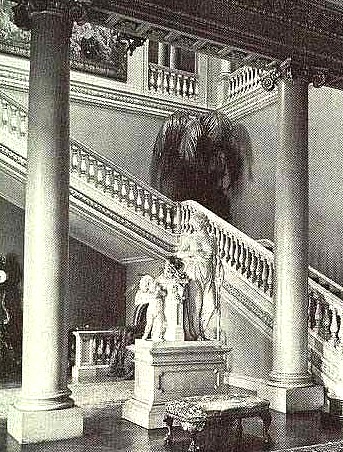2005.03.04 12:01
Re: Versailles, sigh
Brian,
in yahoo maps
address: trumbauer dr
city, state: wyndmoor, pa
will get up right to where the house, Whitemarsh Hall, used to be. Note the Widener Rd leads to the fountain circle and the gates are on East Willow Grove Ave.
Chestnut Hill is in Philadelphia and just next door southwest of Wyndmoor.
I'll try the National Atlas now with the same address. I hope you do continue searching the data you wanted to compile. I know the area, but it will be interesting to see what you, as someone unfamiliar with the real place, come to interpret via the acquired data, and then share/combine our impressions.
'Welcome to Suburbobliviopolis' is how "Here a Versailles, There a Versailles, Everywhere a Versailles, Sigh" ends. The point of this virtual conference paper mostly about 'reenactionary architecturism' inversely culminates with an oblivion engendered via erasure (damnatio memoriae) with ultimate palimpsest. As with any good conference paper, you want to see/receive impressions and constructive reactions (so what you wanted to do further is perfect, as are the reactions at archinect). Additionally, your (intended) study evokes a new(?) kind of archaeology--digging through strata of data in cyberspace, no less!
www.serianni.com/wh0.htm is the best website on Whitemarsh Hall, and what quondam and museumpeace are/will be doing is adding more layers of data, specifically collecting the remains of Whitemarsh Hall. The Philadelphia Museum of Art has the best public collection of artifacts of Whitemarsh Hall, and 5233 Arbor Street has a unique collection of Whitemarsh Hall artifacts as well (although I still have to get my super-8 movies of the place in 1972 translated into digital format.)
Looking forward to seeing what you come up with.
Steve
2005.03.04 12:12
Re: Versailles, sigh
In the panic after Pearl Harbor, German planes were reported nearing the coast; the Boston Museum rushed its treasures out of sight. The National Gallery in Washington very intelligently secured the vast empty Vanderbilt chateau of Biltmore in the North Carolina mountains, to shelter the chief masterpieces of the Mellon Collection. The Metropolitan first thought, on the example of the National Gallery in London, of an abandoned mine or quarry, and was on the point of taking one up the Hudson. Fortunately, the prolonged drought during which they inspected it came to an end, and water began to seep in just before they were to occupy it. Various empty country houses were offered them. Soon they announced they had taken a country place, "a hundred miles inland." It was Whitemarsh Hall. Priorities on materials were somehow secured; steel racks for paintings were put up in the salon, steel shutters at the windows. Packing cases were piled in the billiard and other rooms.
Other institutions sent their treasures there also, so that if a single bomb had landed it would have destroyed them all. The hysterical rush to put things in Whitemarsh Hall inspired Hardinge Scholle of the Museum of the City of New York, who had at first participated in the movement, to call the house a "monument hystérique."
--George and Mary Roberts, Triumph on Fairmount: Fiske Kimball and the Philadelphia Museum of Art (Philadelphia: J.B. Lippincott Company, 1959).
| |
2005.03.04 14:53
Re: Versailles, sigh
A, I fully understand your reaction/impression, and, like all the other responses, here, you're spot on, BUT there's a very rich story here that needs further understanding.
From the air, yes the suburban street layout is "ugly", but the homes from the first wave of developments (1950s and 1960s) are for the most part 'ok' and some are even stylistically interesting, especially those that look to be from the 1950s. And, in general, the old estate is very nice place to live, even desirable. The group of homes built after the mansion was razed 1980, are the worst though.
If you read through the guest book at http://www.serianni.com you'll see that for those that grew up near or knowing about the place, the derelict palace was something beyond enchanting. My older brother first took me there in 1970 when he got his driver's license. I was a freshman in high school then, and it was like my first architectural wet dream come true. My goal became to get into every room of the place, and I almost succeeded. Now it's like Learning from Whitemarsh Hall.
Abracadabra's archaeological evocation is great. Very Piranesian. There's reenactment, damnatio memoriae (erasure of memory) and ultimately palimpsest. The landscape telling a story via strata of data.
I have some treasured "souvenirs" gotten by teenage vandalism (barbarian that I was)--a baluster from the forecourt and two slabs of marble from Mr. Stotesbury's bathroom (one of which has Anonymous Saint In Bikini While Jesus Is Walking on Water painted on it). Plus I still have some super-8 movies of the place in 1972 that need to be transferred into digital media.
quondam (from the Latin) once, at one time, formerly; at times, sometimes, once in a while; some day, one day (in the future)
2005.03.04 15:54
Re: base maps
Thanks for posting the street map.

Note some of the street names. Stotesbury and Trumbauer, obviously. Cromwell was Eva's first husband (before Ned Stotesbury). Eva's daughter (from the first marriage) married Douglas MacArthur. (Eva's son, James(?) Cromwell, married Doris Duke.) Duveen, the aesthete and fine art dealer told Eva she should build a palace (with a good chunk of Ned's money going into Duveen's pockets). And the Wideners had Trumbauer build Lynnewood Hall which is stylistically the older sister of Whitemarsh Hall.
Remember when we wrote about place names. I was looking for cedar trees in what used to be Cedar Grove, and you noted the birthplace of Oakland "without an oak tree in sight."
Is this all indicative of how 'modern oblivion' operates?
(The art/theory journal) October 25 devoted the entire Summer 1983 issue to Leo Steinberg's The Sexuality of Christ in Renaissance Art and in Modern Oblivion. I'm pretty sure Steinberg's title is what inspired Anonymous Saint in Bikini While Jesus is Walking on Water.
note to self 2004.01.26
more novel ideas
16. Gordon Matta-Clark is coming to the [Horace Trumbauer Architecture Fan Club] convention because he used to break stuff at Stotesbury [which is how most locals used to refer to the place, actually, I first heard of it as Stokesbury]; he claims to have broken most of the windows, etc. Gordon is staying in the old Sears power plant. [Matta-Clark died in 1978, right before some of his work was to be exhibited at the Institute of Contemporary in Philadelphia. All the windows of Stotesbury were broken by then, but he still enjoyed 'haunting' the place till it was gone.]
| |
2005.03.04 Martha Stewart released from prison
2005.03.06 13:41
In The Future Everyone Will Have...
We know what happened when the 'plane of the present' sliced through the navel, so which future are we talking about here? Are you wondering about when the present slices through the duodenum? or the liver? or the crest of the diaphragm? Or perhaps you are wondering about when the present slices through the heart and the lungs? Or are you wondering about the big age of cutting-off-point as the present slices through the neck? What will humanity be when the present slices through the head?
2005.03.06 17:56
Re: Versailles, sigh
Well guess what?!? Since you've lived right off Germantown Ave. you can tell everyone that you likewise lived right off a street President George Washington once lived on. The Deshler Morris House at 5442 Germantown Ave. briefly served as the 'Executive Mansion' during Philadelphia's yellow fever epidemic 1973-4(?) and the government (Philadelphia was US Capital 1790-1800) sought safety in Germantown.
The Deshler Morris House is still there, but the King of Prussia Tavern a block up, where Jefferson stayed and Washington often ate, is gone. It's the Risqué Beauty Parlor and DollarLand now. Stotesbury also lived in Germantown (on Tulpehocken St.) when he was a widower with two daughter's.
 
Jean-Pierre-Antoine Tassaert
Love and Friendship
(The Sacrifice of the Arrows of Love on the Altar of Friendship)
1776
marble
Today there are some very nice sculptures from Whitemarsh Hall at the Philadelphia Museum of Art--given by Eva in memory of Ned. The sculpture that was in the Stairhall, before that, belonged to Frederick the Great. Imagine that, real live King of Prussia marble.
And, speaking of industrialists, how about Martha Stewart's coincidental Versailles sigh of relief? I can't wait to read her guide to Creative House Arrest.
|